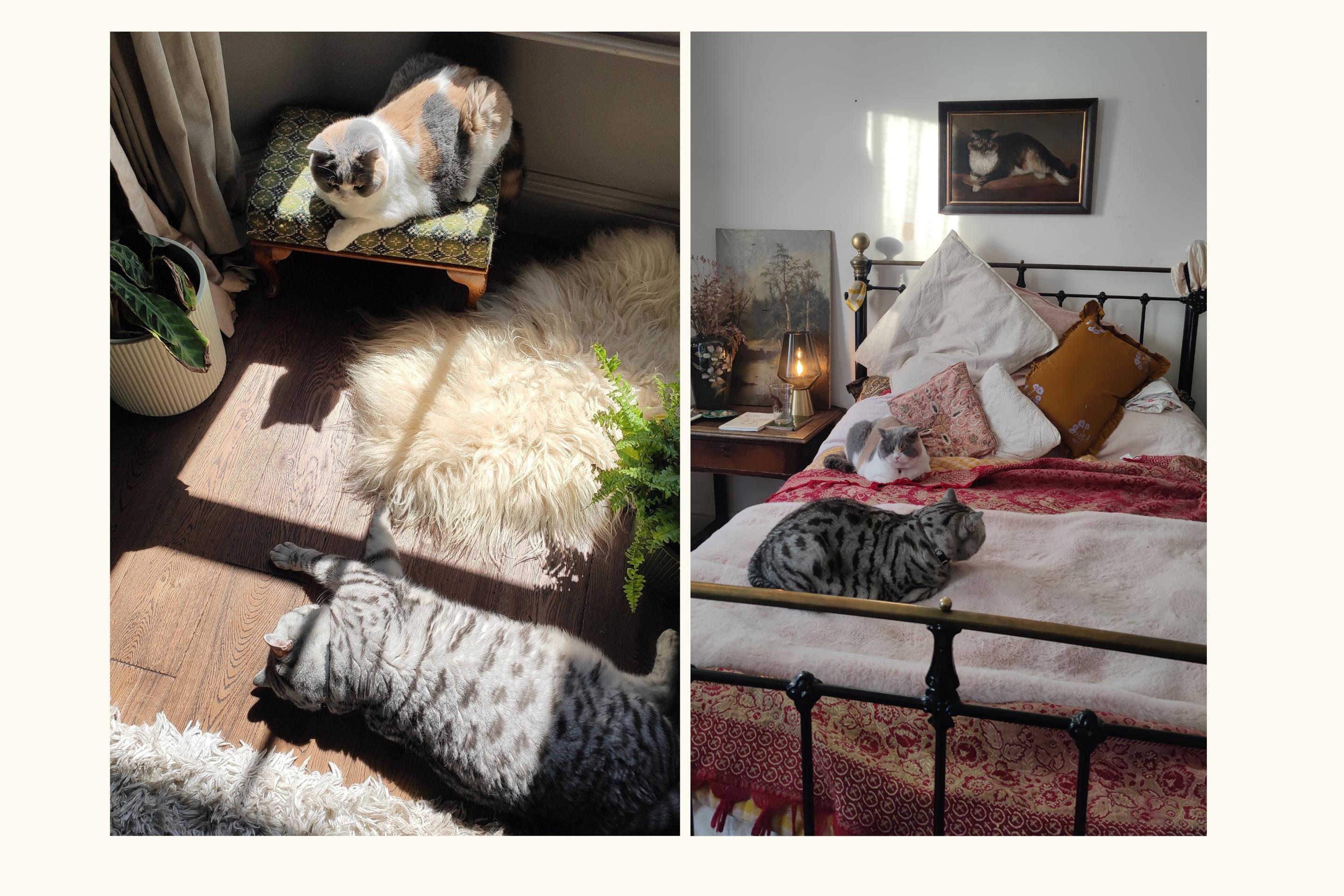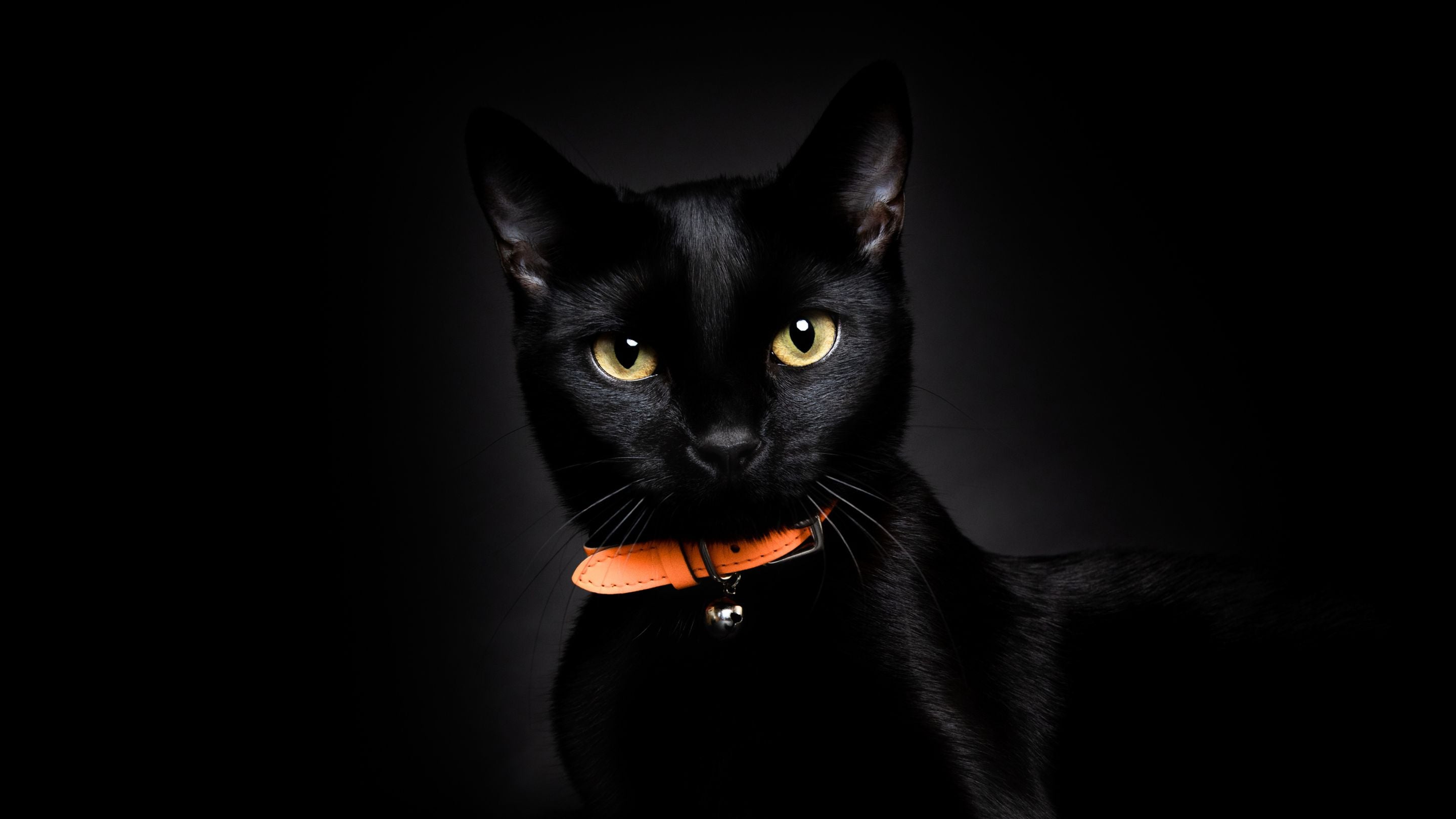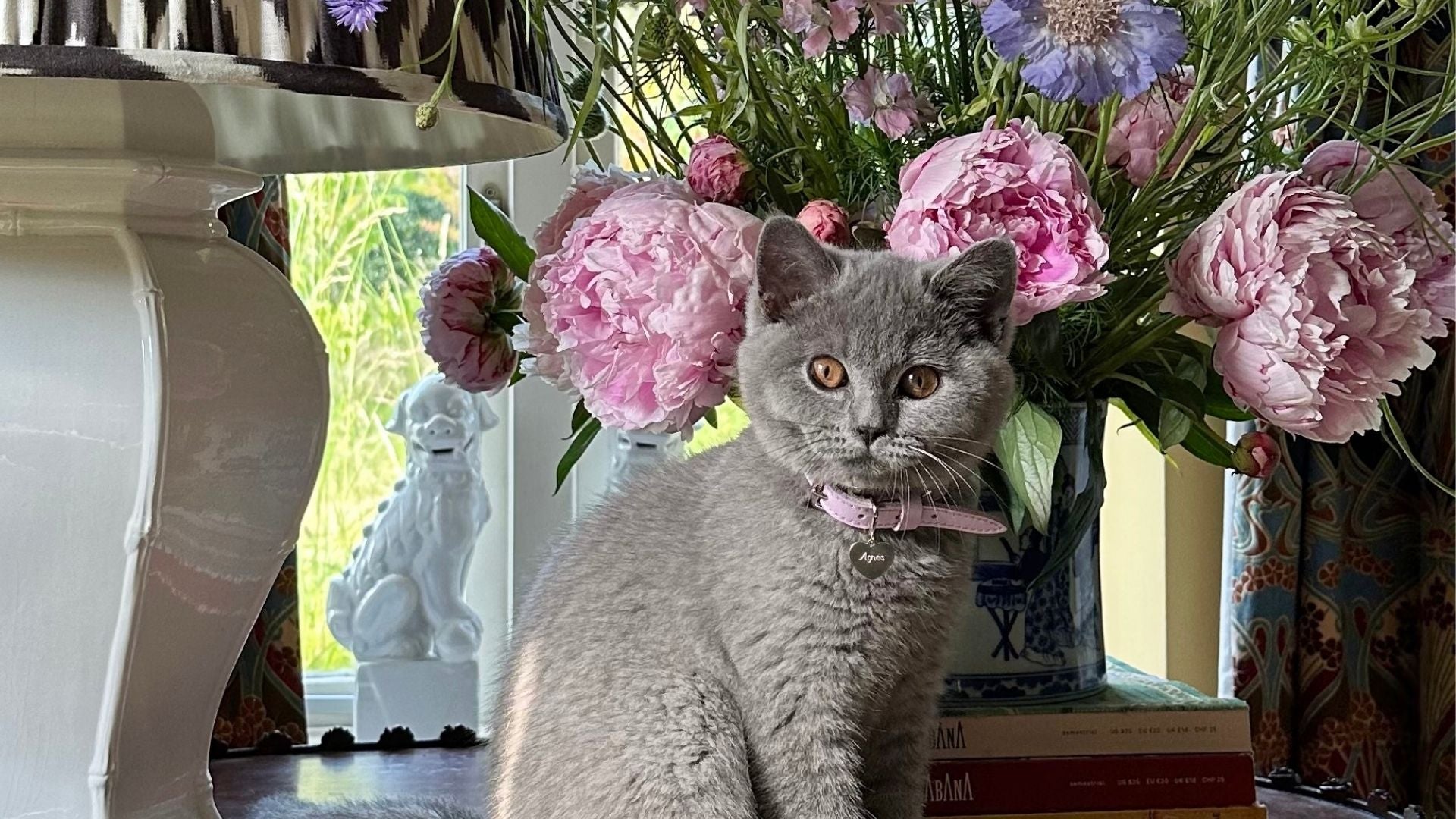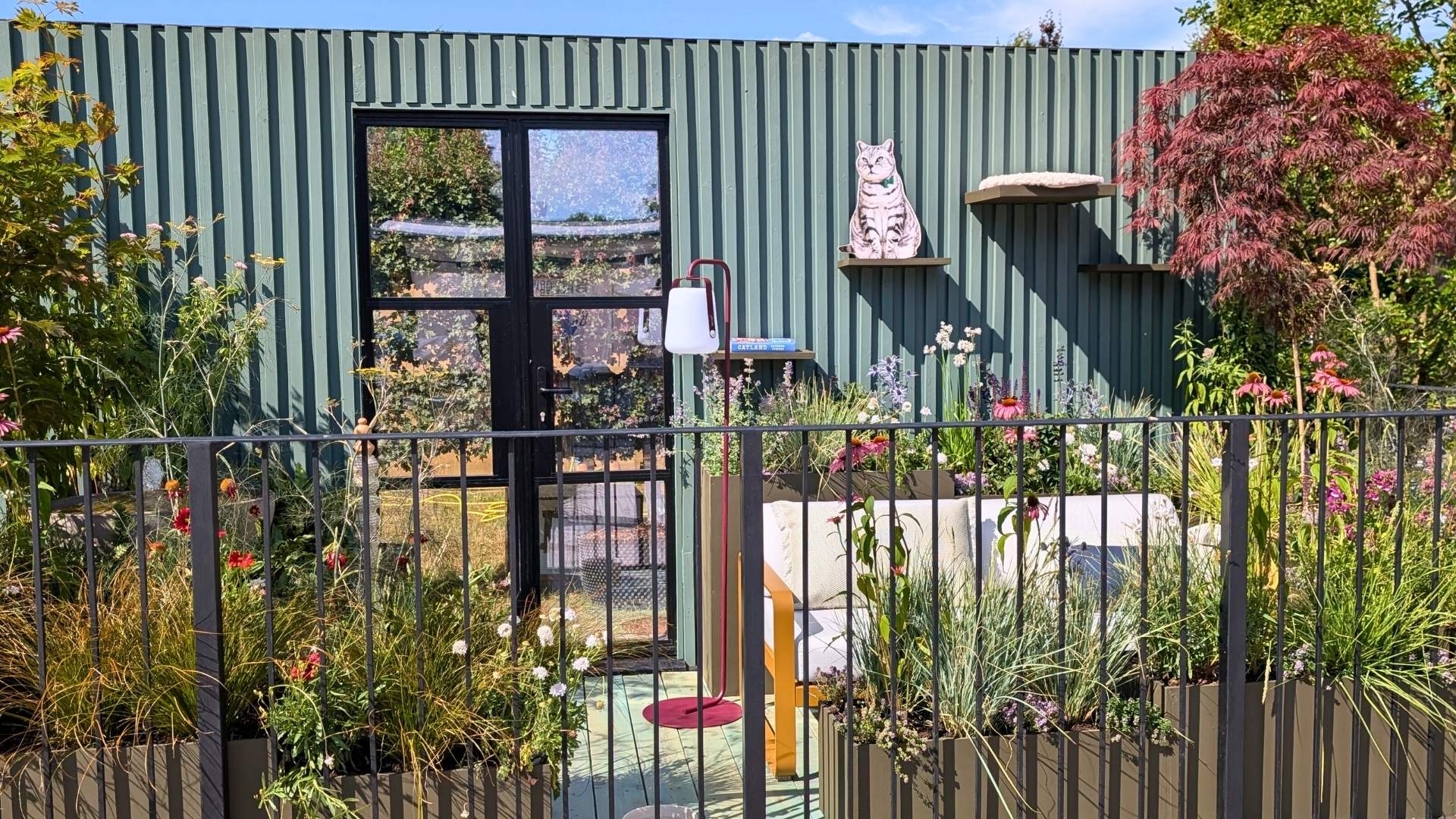Providing your beloved feline with food, shelter and of course love are the basics for creating a strong bond with your cat, but how do you make your house into a happy, safe and secure home for them? In this guide, we share the essential things that will help make your place cat-friendly and help your kitty thrive.
Cat proof your pad ‘Curiosity killed the cat’ is no joke, so whether you are bringing home a new puss or are already ‘with feline’, consider potential hazards - from open washing machines and tumble dryers, toxic plants and flowers, dangling wires, poisonous household cleaning products, hot hobs and high-level balconies. Make it second nature to consider your cat’s safety around your home.
Consistent feeding times and high-quality food. Like us, our felines love the stability and calm of a regular routine, and consistent mealtimes are an essential part of that. It maintains a healthy digestive system and means they don’t suffer from anxiety about when and where their next meal will be coming from. Most adult cats require two meals a day (breakfast and dinner), whereas kittens need three meals during their growth spurt. Try to deliver these meals at the same times each day – and make provisions for times when you can't do this.
A regular feeding routine can be a little trickier in a multi-cat household so if that’s you, our advice is to observe how your cats interact with one another, to ensure one cat isn’t eating everyone’s share. Percy (my 10-year-old boy) is often hungry and always happy to eat, so he will tuck into Penelope’s (my 3-year-old girl's) food if she doesn’t finish it, which is problematic for both of them. Penelope doesn’t seem to like eating early in the day, so I feed her breakfast later in the morning and put Percy in the other room so she can enjoy her meal in peace.
In terms of what you feed your cat, there is a vast and varied amount of choice, but as we're not pet nutritionists, we won’t tell what type or brand to feed your cat. We simply suggest giving them the best food you can afford that is appropriate for their age, life stage, condition or medical issue. A good diet will show in your cat through bright eyes, a healthy coat, a good appetite and a healthy weight. Plus, it will also reduce strong odours from their litter tray.
Create their space & establish boundaries. Keep your cat’s essentials (bowls, bed, litter tray, etc.) in the same spot, so they always know where to find them and feel they have their own spaces in your home. Read on for tips on the best items to choose and where’s good to place them.
Maintain access or restrictions to certain rooms in your home, although this can be easier said than done. My cats are allowed free access to my bedroom during the day but come bedtime, they are restricted to downstairs otherwise they will scratch my bedroom door for access and disturb my sleep. Occasionally I break this rule when they are all cosy while I read before bed, but this often results in 3 am cat wake-up call with Percy sleeping on my head and Penelope knocking everything off the bedside table.

Should you need to make any changes to their ‘space’, access or even meals, do it gradually, tackling one thing at a time as sudden changes can really affect a cat especially if you get rid of their favourite snoozing spot by moving or changing the furniture.
High resting places and vantage points
Cats love to perch up high, where they can survey their surroundings and feel safe (especially if you also have a dog or small human); offering these spaces - cat furniture, shelving, or even the top of a wardrobe - will satisfy your cat’s need for surveillance over their kingdom. Provide your cat with a safe haven to hide, with items such as an enclosed bed, tepee or even the humble cardboard box lined with an old jumper or a Cheshire & Wain Cat Cloud. If they like to hide behind a piece of furniture, for example, an armchair, or under your bed, let them. A feline friend will also tend to be a keen team member of the neighbourhood watch scheme, so letting them perch on the windowsill or a strategically placed item of furniture will allow them to nosy at the outside world. I’ve put a miniature chair in the downstairs bay window for Penelope, which she loves so much we jokingly call it her bedroom. The curtains are drawn on the bay at night and that’s where she will be found each morning waking up just in time for breakfast.
Toilet time (skip this part if you allow your cat outdoor access). If you have a house cat or restrict your kitty’s time outdoors, the litter tray is a necessary evil of pet ownership. And if you have more than one cat, it’s best for them to have a tray each or an extra deep and large tray they can share. The type of cat toilet management system you choose is very much down to personal choice (and budget!). There’s a wealth of options, from the basic plastic litter tray to electronic litter robots, to contemporary solutions such as a the Poopoopeedo Luxury Litter Box I used to have for Percy. This tray demonstrates that not all toilet solutions are suitable for all cats. Penelope wees standing up, which caused liquid to leak between the base and the lid of this tray. Regrettably, I had to retire the Poopoopedoo for an Ikea 'Sockerbit' storage tub as a result! You can find many Ikea hacks online that discreetly integrate their ‘toilet’ into your home. Whatever you choose, make sure it’s changed or topped up daily and cleaned weekly - cats hate stinky toilets as much as we do!
Best bowls for food and water. Ceramic bowls such as our Porcelain or Stoneware bowls are a better option than plastic. The latter can omit or retain smells that offend your cat; some cats can also be allergic to plastic and get cat acne around their chin from it. Steel bowls, while very hygienic and easy to clean, may frighten your cat every time their collar’s hardware or bell makes contact. If you have more than one cat where different diets are needed or live with a dog, you might want to consider a Microchip Feeder, which exclusively serves meals to the chip holder.

Cat bed and beyond! The catnap is a full-time and enjoyable career for a cat – and they will choose various locations in your house to conduct this important activity. The spots may change throughout the day, but a cat bed or furry throw will encourage them to sleep in a specific spot/s. From a homeowner’s perspective, this helps contain shedding fur and avoids claws spoiling soft furnishings. As many cat owners know (us included) cat-specific beds can sometimes be ignored with a preference for human beds, sofas or cushions, which is why we developed the Cat Cloud® collection - our range of thermal beds and faux fur throws we also offer a range of sheepskin rugs which make cosy areas for sublime catnaps. These can be placed in your cat’s favourite locations for extra cosiness whilst protecting your home and furniture from their fur and claws.


Strategic placement. Cats have their own ways, and this has a bearing on where their life essentials are placed throughout the home. They prefer to have their food bowls in low footfall, quiet spots so they can enjoy their food in peace. This might be in a hallway, utility room or even a counter or shelf – particularly if there’s a dog or young children. Separating their food from their water is also advised, as it satisfies their natural need to hunt. We also recommend placing more than one source of water around the home and freshen it up a few times a day to ensure your cat is drinking plenty. Water is essential to a cat’s health, as it helps maintain a healthy kidney function by flushing out toxins from the blood. If you notice that your cat doesn’t drink much water, you can try a pet water fountain or even turn the kitchen tap on for your cat to play and drink from (some kitties adore this fun activity).
Where their cat toilet is placed also needs to be considered. Position away from their food and water, in another low traffic, quiet spot, ideally in a quiet corner or against a wall, so they have a 180-degree view to feel safe from danger and have some privacy while doing their business.
Give them something to scratch. Scratching is instinctive for cats. They do it to mark their territory, shed their claw casings, express their emotions, or simply for the pleasing feeling of a stretch! Repeated scratching of your furniture, carpets and soft furnishings will quickly cause them to fall into disrepair, so a few purpose-built cat scratching areas are fundamental in the cat-friendly home. There are many options when it comes to cat scratchers, from inexpensive and straightforward scratching posts and pads to high-end cat scratching furniture with an expensive price tag. Whatever you go for, place where the cat wants it, not you, by observing where they seem to want to scratch. If going for a post, choose one that allows your cat to scratch at full stretch and make sure it’s sturdy, so it doesn’t topple over. Don’t expect any scratching furniture to last a lifetime; repairs and even replacement will be necessary over time as this item will be used often. A cat scratcher can also be made relatively easily with some sisal rope, a wooden post or cardboard tube and a glue gun. I made Percy & Penelope’s scratching post from a discarded bannister post, and it’s still going strong after five years of regular use.
Playtime is also essential to a cat’s happiness and wellbeing, as it helps offer physical and mental exercise for your cat. But cat toys is a topic all on its own and one that we will be exploring and sharing in our journal soon so watch this space. Or read how to show your cat affection with a routine of rest and play here
Fresh air & pheromones
Us humans tend to dislike a stuffy, stale room full of recirculated air; cats are not much different. Open the windows to let in fresh air for your cat and let them position themselves near it, such as on a windowsill. Just be sure it’s not open enough that they can escape if they are an indoor kitty, or you live above the ground floor.
Cat flap and the outside world
Of course, a cat-friendly home extends to your outdoor space too and it’s a topic we will be writing about in more detail soon but giving your cat access to the outside world helps provides additional exercise and stimulation. If you are confident and happy for your kitty to go outside, a cat flap will allow them to come and go as they please. Today’s cat flaps will also enable you to dictate when they can go outdoors, for example, they can be locked in the evening so your cat is home at night-time – and the microchip varieties will stop neighbourhood cats from intruding into your cat’s territory to steal their food.

Should you wish to give your cat access to outside but the thought of them straying far from home makes you anxious, there are companies that can cat-proof outdoor areas including gardens, balconies and patios to provide a safe, additional outside ‘room’ for your little explorers. In fact, the ‘catio’ is becoming increasingly popular with cat owners with indoor cats.
Whatever outdoor access you give your cat, we strongly recommend they wear a collar with an ID tag. We offer complimentary engraving on all our ID tags, to ensure your cat’s safe return if they get lost. Plus, all our luxury leather collars come with an optional bell, which helps give prey early warning of your cat’s presence, making it less likely that you will discover one of your cat’s special presents lying dead or injured in your home.
We love seeing your cats having a lovely time in their homes, so please tag us in your pictures @Cheshireandwain




Share:
Let sleeping cats lie | Why does my cat sleep so much?
Made with Love in England